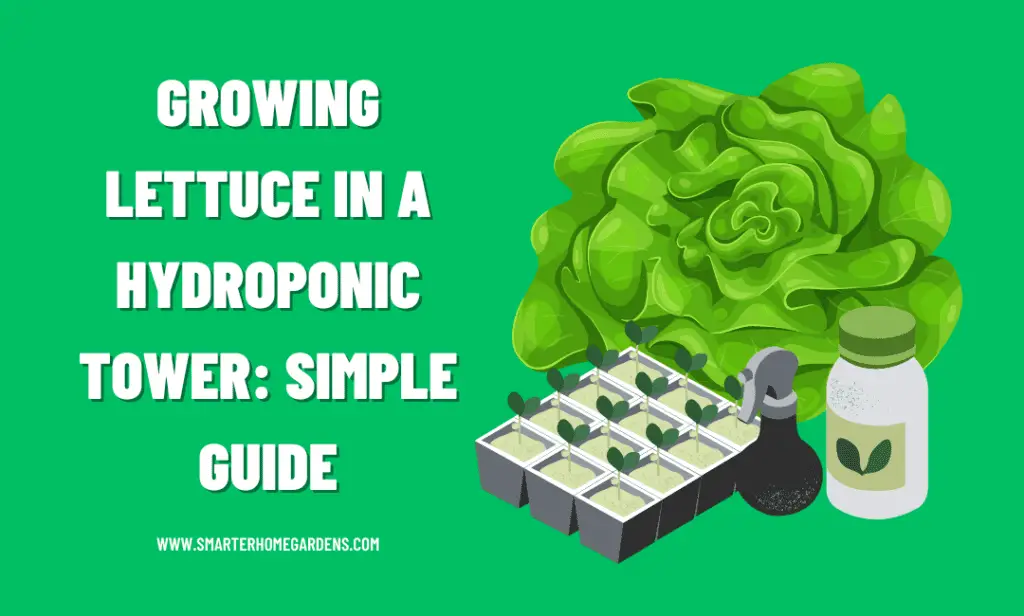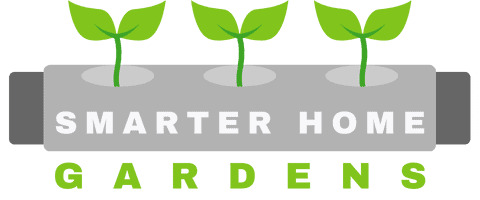This article contains affiliate links. As an Amazon Associate, SmarterHomeGardens.com earns a small commission on qualifying purchases at no extra cost to you.

If you’re looking for a way to grow fresh, crisp lettuce in a limited space, then growing lettuce in a vertical hydroponic tower might be the answer.
A hydroponic tower can be used to successfully grow a variety of lettuce types, including romaine, butterhead, and loose-leaf. By growing lettuce in a vertical hydroponic tower, you can maximize your space and produce a high yield of fresh greens without the need for soil.
This article will cover everything from optimal lettuce varieties to proven growth strategies to guide you on how to cultivate beautiful lettuce at home using a vertical hydroponic system. Let’s get started.
How do hydroponic towers work?
Hydroponic towers are one of the most space-efficient hydroponic systems out there. As such, I have found them to be a great way of growing leafy greens at home, both indoors and out.

Top tip: Read my in-depth article Hydroponic Towers: What are they and how do they work?
A hydroponic tower usually consists of a tall, cylindrical setup featuring rows of openings where plants are placed, often held securely in net cups.
A water solution enriched with nutrients is circulated to the top of the tower and then cascades downward, bathing the plant roots in vital nutrients needed for growth.
Why lettuce is perfect for vertical hydroponic systems
When I first started exploring the world of hydroponics it quickly became apparent that lettuce is a match made in heaven for vertical hydroponic systems.
Short growth cycles
Lettuce has a relatively short growth cycle. This means you can enjoy fresh, homegrown lettuce in a matter of weeks rather than waiting for months.
Compact roots
Additionally, lettuce roots are compact and not overly invasive. In a vertical setup, this ensures that the roots from one plant don’t overshadow or strangle the ones below.
Low light requirements
Moreover, lettuce isn’t too demanding when it comes to light. While they thrive under optimal lighting conditions, they’re also forgiving if the light is slightly less than perfect. In a vertical system, where guaranteeing a uniform light distribution can be tough, this trait of lettuce is an advantage.
Aesthetics
Finally, the aesthetic appeal cannot be ignored. Picture tiers of various lettuce varieties – romaine, loose leaf, butterhead – cascading down a tower. It’s not just food; it’s art!
Choosing the best lettuce varieties
Vertical hydroponic towers provide an excellent environment for a myriad of lettuce varieties. Whether you’re looking for something crisp for your sandwiches or soft for your salads, there’s likely a lettuce variety that’ll thrive in a vertical setup.
Let’s delve into some of the best picks.
1. Classic Romaine (Cos) Lettuce
Romaine, often referred to as “Cos” lettuce, stands out with its tall, sturdy leaves and crisp texture. Native to the Mediterranean region, this lettuce variety is celebrated for its resilience and adaptability, making it a preferred choice for many gardeners.

Its upright growth habit makes it particularly well-suited for vertical hydroponic systems.
Beyond its gardening merits, Romaine is nutritionally rich, packed with vitamins A and K. It’s also the star ingredient in Caesar salads, loved for its crunchy bite and slightly bitter undertone.
Butterhead Lettuce
Butterhead lettuce, encompassing varieties like Bibb and Boston, is renowned for its tender, buttery-textured leaves that form loose, round heads.
Originating from temperate regions, this lettuce variety has a mild flavor and a slightly sweet undertone, setting it apart from its crunchier counterparts.

Its compact nature and soft leaves make it an excellent choice for sandwiches, wraps, and delicate salads. When grown in vertical hydroponic systems, Butterhead’s moderate size ensures efficient spacing, while its attractive green hues offer both visual appeal and a promise of garden-fresh taste.
Loose Leaf
Loose Leaf lettuce, available in both green and red varieties, is distinguished by its vibrant, ruffled leaves that sprout directly from the stem rather than forming a tight head.
This lettuce is the epitome of flexibility.

Hydroponic growers love it because individual leaves can be harvested as needed, allowing the plant to continue growing and producing. This “cut-and-come-again” feature makes it an ideal candidate for vertical hydroponic systems, promoting sustained yields over extended periods.
Iceberg
Known for its iconic crisp texture, Iceberg lettuce is a staple in many salads and sandwiches. Its round, tightly-packed head resembles a cabbage, providing layers upon layers of crunchy, water-rich leaves.

When adapted to hydroponic systems, especially vertical towers, it requires ample spacing due to its broad head. Its mild flavor and cool, crisp nature have solidified its place as a classic choice in the world of lettuce.
Tips for growing lettuce in a hydroponic tower
1. Provide adequate light
For lettuce, lighting is crucial. While they can tolerate some variations, optimal growth is achieved with 10-14 hours of light daily. If you’re using artificial lights, ensure they cover all plants evenly, especially in a stacked vertical system. LED grow lights can be an energy-efficient choice.
2. Choose the right mix of nutrients
Lettuce has specific nutrient needs. A balanced hydroponic nutrient solution, rich in nitrogen, potassium, and calcium, will promote healthy growth.
Top tip: Read my article on how to change the nutrient solution in hydroponics.
Monitor the pH level, aiming for a range of 5.8 to 6.2, to ensure nutrient absorption.
3. Monitor for pests and diseases
While hydroponic systems generally face fewer pest challenges, always be vigilant. Aphids or root rot can occasionally be an issue. Regular inspections and maintaining clean water will help deter most problems.

4. Keep your vertical tower clean
Although the highlight of hydroponically growing lettuce is undoubtedly the harvest, maintaining a consistent cleaning routine is essential.
This not only prevents the buildup of algae, harmful bacteria, and mold but also ensures their timely removal. Such contaminants can compromise the health and quality of your lettuce.
5. Harvest your lettuce at the right time
One of the joys of lettuce is its continuous growth. For leaf varieties, harvest outer leaves when young and tender, allowing the center to keep producing.
For head varieties like iceberg, wait until the head feels firm and has reached its full size before harvesting.
Germinating and transplanting lettuce seeds
Germinating your seeds
For varieties of leaf lettuce, sow 2–4 seeds in each rock wool cube. However, for head lettuce varieties, use just one seed per cube.
Top tip: Read my article on how many seeds to sow in each rock wool cube for lots of different plant varieties.
Typically, lettuce seeds sprout within 1–2 weeks.
Transplanting your seedlings into your hydroponic tower.
Once the seedlings display 2–3 leaves and a noticeable root system, which usually occurs 10–14 days post-sprouting, they’re ready for transplanting to your hydroponic tower.
Remember, positioning lettuce closer to the top of your Tower Garden is advisable if you are growing other types of plants, such as tumbling tomatoes, for example.
Top tip: Read my guide on how to organize your vertical hydroponic tower for maximum success.
Growing your lettuce to maturity
Mixing the right nutrients
Nitrogen plays a pivotal role in leaf development, making it crucial for lettuce growth. Optimal hydroponic nutrients for lettuce will also encompass trace amounts of micronutrients.
Notably, boron, copper, iron, and manganese are among the essential micronutrients for lettuce cultivation.

Which are the best nutrients to buy? For a good general-purpose nutrient mix that works great for lettuce, my go-to is General Hydroponics’ FloreSeries three-part mix.
Optimal pH levels for lettuce
You’ll want to keep pH levels between 5.5 and 6.5 to keep your lettuce nice and happy.
I’d recommend purchasing a pH monitor to help you stay on top of this. Don’t underestimate how important pH is.
Best pH meter? My favorite meter is the 4-1 Hydroponics Metre by Yinmik.

I made that mistake in the early days and if you get it badly wrong your lettuce won’t taste good and growth can be sub-optimal.
Optimal temperature for growing lettuce
Lettuces predominantly flourish in milder climates, often being cultivated outdoors during the brisk months of spring or fall. This makes it a great crop for growing in colder regions.
As a rule of thumb, the ideal germination temperature for lettuce ranges from 65° to 80°F. Obviously, your ability to control the environment will largely depend on whether your system is inside or outside.
Top tip: Check out my article comparing outdoor with indoor hydroponics.
After they’ve taken root, it’s beneficial to reduce the temperature a bit if you can, aiming for approximately 55°F at night and 75°F in daytime hours.
Providing the right amount of light
While lettuce generally doesn’t require much light compared with other hydroponic crops I’d still recommend that your lettuce seedlings get around 14-18 hours of light each day (supplemented by grow lights if necessary), complemented by a 6-hour dark period.
After they’re well-established, aim to provide your hydroponic lettuce with 10-12 hours of light daily.
How long does it take to grow lettuce hydroponically?
If you do everything right (following this guide to a tee of course!) then your lettuce should go from seed to table pretty quickly.
Lettuce generally has a short growth cycle of around 10-12 weeks. What’s more, is that they can often be harvested more than once which makes them a popular crop for growers (and salad lovers!).
Average growth times
| Romaine | Butterhead | Loose Leaf | Iceberg |
|---|---|---|---|
| 60-80 days | 45-60 days | 45-55 days | 50-90 days |
Harvesting your hydroponic tower lettuce
Lettuces are known for their rapid growth, often reaching harvest-readiness just a few weeks post-planting. When it’s time to harvest, there are two primary methods to consider:
Whole head harvesting
This involves removing the entire lettuce plant and its associated net pot from your hydroponic tower. Alternatively, you can cut all leaves right at the plant’s base.
If opting for this method, it’s wise to have backup seedlings on standby for replanting.
Individual leaf harvesting
This approach allows the lettuce plant to remain alive, promoting sustained growth. Once you observe a substantial number of mature leaves you should harvest sparingly, taking just a few leaves at a time, starting from the plant’s base and working upwards.
Always ensure at least 2–3 leaves are left behind, allowing the plant to continue its growth.
Repeat this process every couple of days. However, once the plant starts bolting (beginning to flower), it’s time to replace it with a new seedling.
Benefits of growing lettuce hydroponically
Lettuce grown hydroponically boasts the same health advantages as those cultivated in soil. Rich in vitamin K, it supports bone health.
Given that it consists of nearly 95% water, it offers hydration, while its vitamin A content benefits eye health.
Top tip: Read my article on whether or not hydroponically grown food tastes better or not.
Moreover, hydroponic lettuce has a lower risk of contamination than soil-grown counterparts.
Common problems with growing lettuce hydroponically
Growing lettuce hydroponically comes with its set of challenges. Here’s a brief overview of common issues and their potential triggers:
- Burned or Wilted Leaves: Often indicate a deficiency in calcium within the nutrient solution.
- Premature Bolting: This can be a sign that the temperatures within your growing environment are excessively warm.
- Limp Leaves: Multiple factors can cause this, including inconsistent water levels, extreme heat, inadequate light, or even fungal infections.
Top tip: Read my article on 19 common problems with hydroponics to learn more about some of these challenges.
Conclusion
Harnessing hydroponic towers offers an efficient and sustainable method for growing lettuce. By understanding the intricacies, from selecting the right type to addressing common challenges, you can soon yield consistent and fresh produce throughout the year.
Let me know how you get on! Get in touch through my contacts page. I’d love to hear from you.
